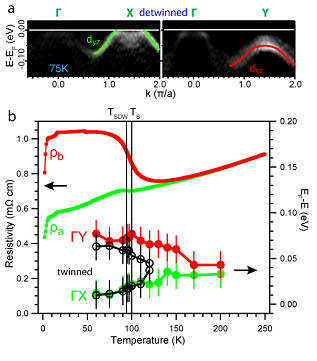High temperature superconductivity (HTSC), one of the long-standing unsolved mysteries of condensed matter physics, is a beautiful example of emergent phenomena in which new orders arise not from properties of their individual constituents but rather the competitive or cooperative interactions amongst them. HTSC was first realized in the copper-based oxides (cuprates) over two decades ago. Three years ago, a second family of HTSC, known as the iron pnictides, was discovered, opening a new playground to compare and test those HTSC theories already formulated based on the cuprates. Among the many quickly revealed properties of the pnictides are quite a few that showed surprising similarities to the cuprates. One major such similarity is the existence of competing orders in proximity to the superconducting state in their phase diagrams.

In the cuprates, the underdoped regime is dominated by an antiferromagnetic phase, which is suppressed by doping, allowing the emergence of superconductivity, underneath another mysterious phase known as the pseudogap phase. In the pnictides, the competing orders to HTSC take form in a collinear spin density wave (SDW) order and the associated magnetic phase transition is always accompanied by a tetragonal to orthorhombic structural transition. Only the suppression of these orders with chemical doping or pressure allows the emergence of superconductivity in the pnictides. As these orders are intimately related to HTSC in the pnictides, an understanding of their nature can provide much insight to the requirements of HTSC.
In a study recently published inProceedings of the National Academy of Sciences, researchers Ming Yi and Donghui Lu along with their co-workers in Prof. Zhi-Xun Shen’s group, Prof. Ian Fisher’s group and Prof. Tom Devereaux’s group at Stanford University performed angle-resolved photoemission spectroscopy (ARPES) at SSRL Beam Line 5-4 and ALS Beam Line 10 to study the electronic structure of a family of electron-doped iron pnictides, Ba(Fe1-xCox)2As2, across the competing phases. As naturally occurring twin domains in the orthorhombic phase prevented previous ARPES studies from resolving the intrinsic electronic structure, the application of an in-plane uniaxial stress allowed this study to make the first ARPES measurements on detwinned crystals. This endeavor revealed a clear in-plane electronic anisotropy in the orthorhombic SDW state, characterized by a large energy splitting between two orthogonal bands with dominant dxz and dyzcharacter that are otherwise degenerate in the high temperature tetragonal paramagnetic state (Fig. 1a). This is important as it shows that C4 rotational symmetry is broken in the orbital degree of freedom. Furthermore, this symmetry breaking is observed to be developed almost completely before the SDW order sets in (Fig. 1b), suggesting that it is not a trivial result that follows the symmetry breaking of the spin degree of freedom at lower temperature as some have suggested.
This finding is especially relevant as recent experiments have found various signs of symmetry breaking in the pseudogap phase in proximity to HTSC in the cuprates, raising the question of whether symmetry-breaking competing orders are necessary to HTSC, and if so, what kind of symmetry breaking process is critical? In this regard, it brings to attention that the pnictides are different from the cuprates in the sense that pnictides are multi-orbital materials whereas cuprates are single-orbital. As established HTSC theories based on cuprates largely ignore the orbital degree of freedom, this finding shows that at least for the pnictides, the orbital degree of freedom may play an important role and should be considered when formulating theories for HTSC.
M. Yi, D.H. Lu, J.-H. Chu, J.G. Analytis, A. P. Sorini, A. F. Kemper, B. Moritz, S.-K. Mo, R. G. Moore, M. Hashimoto, W.-S. Lee, Z. Hussain, T. P. Devereaux, I.R. Fisher, and Z.-X. Shen,PNAS 108 (17), 6878-6883 (2011).




